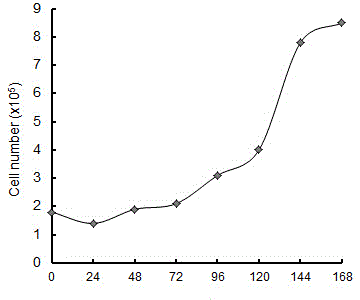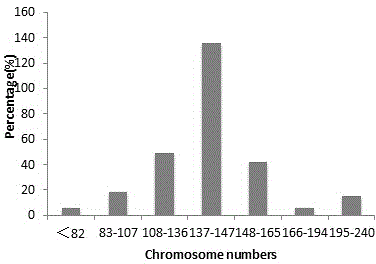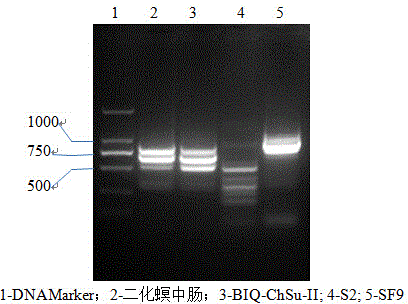Chilo suppressalis larva midgut cell line with high yield of baculovirus
A technology of baculovirus and diploid borer, applied in the direction of animal cells, viruses/phages, microorganism-based methods, etc., to achieve the effect of strong repeatability and good culture effect
- Summary
- Abstract
- Description
- Claims
- Application Information
AI Technical Summary
Problems solved by technology
Method used
Image
Examples
Embodiment 1
[0037] Example 1. Establishment of cell lines in the midgut of Chilo suppressalis larvae
[0038] (1) Prepare cell primary culture medium and cell subculture medium;
[0039] (2) Under sterile conditions, immerse the larvae of C. borer in 75% ethanol solution, disinfect the surface for 10 minutes, wash the larvae twice with sterile distilled water, dry the larvae with sterile filter paper or use Dry the worms with a hair dryer;
[0040] (3) Place the worm body in a dissecting wax dish sterilized with 75% ethanol, fix the head and tail with a dissecting needle, and take out the midgut of the larvae;
[0041] (4) Wash the tissue with normal saline (3) for 3 times, then wash the tissue twice with HBSS cleaning solution, and finally wash the midgut once with cell culture medium TNM-FH, the HBSS cleaning solution contains 200U / ml penicillin , 0.2 μg / ml streptomycin, 0.5 μg / ml amphotericin B;
[0042] (5) Cut the washed midgut tissue into small pieces and place it in a T-25 cm me...
Embodiment 2
[0046] The biological characteristic observation and determination of embodiment 2 cell lines
[0047] (1) Morphological characteristics: Observed under a microscope, the cell line grows adherently, and there are three main cell shapes: most are round, a few are spindle-shaped, and less macrophage-like ( figure 1 ). Round cells account for 90%, with an average diameter of 12.49±1.15 μm; spindle cells are about 21.0-40 μm long, and the average width is about 11 μm; macrophages are between 20-22 μm in diameter;
[0048] (2) Cell growth: the growth curve is a typical "S", and the population doubling time is 78 hours ( figure 2 );
[0049] (3) Karyotype analysis: the chromosome number n=29 of Chilo suppressalis, while the chromosome number of the cell line established by the present invention is 136-147, therefore, the newly established cell line is composed of pentaploid cells ( image 3 );
[0050] (4) DAF-PCR identification: use interleukin-1β to design primers, and use D...
Embodiment 3
[0051] The mensuration of embodiment 3 virus sensitivity and output
[0052] Determination of sensitivity of cell lines to Brassica cabbage nuclear polyhedrosis virus: Take cells in the logarithmic growth phase and prepare 1x10 6 / mL concentration, inoculated into culture flasks, 10mL per bottle. After culturing for 3 hours, the medium was discarded, leaving the adherent cells, and the prepared virus liquid was inoculated on the cells, 100uL per bottle. After cultivating for 7 days, harvest cells and virus polyhedrons, count the number of virus polyhedrons under a microscope with a hemocytometer, and as a result, the polyhedron concentration produced by the cell line of the present invention reaches 16.5×10 6 / PIB / mL. At the same time, typical cytopathological features can be observed, that is, the nucleus is enlarged and contains a large number of polyhedron particles ( Figure 5 ).
PUM
| Property | Measurement | Unit |
|---|---|---|
| Diameter | aaaaa | aaaaa |
Abstract
Description
Claims
Application Information
 Login to View More
Login to View More - R&D
- Intellectual Property
- Life Sciences
- Materials
- Tech Scout
- Unparalleled Data Quality
- Higher Quality Content
- 60% Fewer Hallucinations
Browse by: Latest US Patents, China's latest patents, Technical Efficacy Thesaurus, Application Domain, Technology Topic, Popular Technical Reports.
© 2025 PatSnap. All rights reserved.Legal|Privacy policy|Modern Slavery Act Transparency Statement|Sitemap|About US| Contact US: help@patsnap.com



